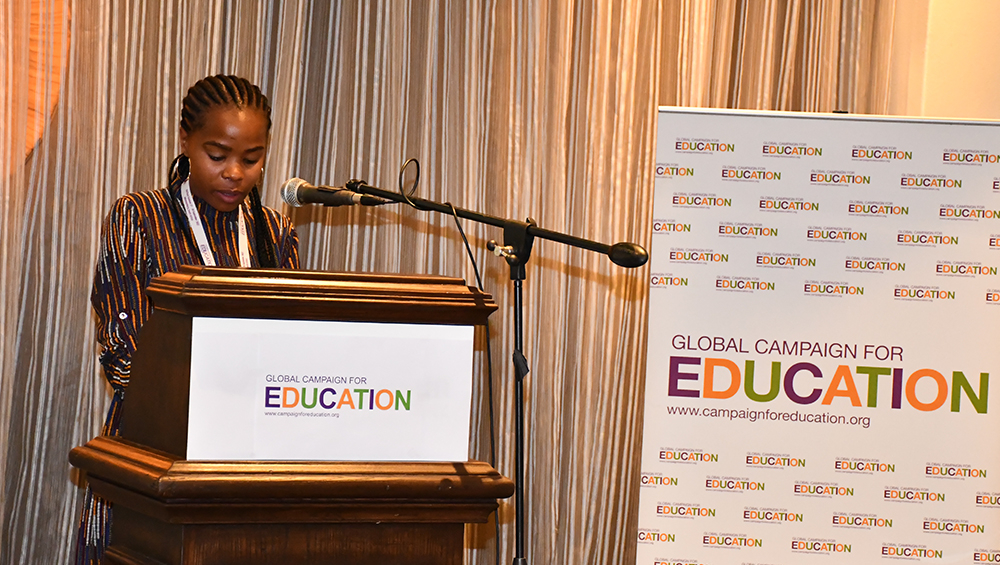Harnessing Education Technology Research Seminar Lessons and Best Practices from Namibia

GCE has convened members from Burundi, Democratic Republic of Congo, Madagascar, Malawi, Namibia, Rwanda, and Zambia for a two-day seminar on Harnessing Education Technology as a Response to COVID-19 in Johannesburg, South Africa, from 27 to 28 September 2022.
GCE is happy to share with you the following reflective lessons from Namibia:
Lessons and best practices from Namibia
Presented by: Loide Shaanika, Secretary General of Namibia National Teachers Union (NANTU) and Mr. Martin Matsuib, Namibian Education Coalition for Civil Society Organisations (NECCSO).
In its COVID-19 response framework, Namibia was one of a small handful of countries that used six or more delivery channels to mitigate the negative impact of school closures on its children during the pandemic (Rodriguez, Cobo, Muñoz-Najar & Sánchez, 2020). Namibia's media mix for distance learning included radio, television, paper, SMS and social media, learning platforms provided by others and platforms created by the government (Rodriguez, Cobo, Muñoz-Najar & Sánchez, 2020; Dreesen et al., 2020). UNICEF partnered with the country's Ministry of Education, Arts and Culture (MoEAC) to provide more than five million paper-based instructional materials to 600,000 students, i.e. all primary school learners and pre-primary learners (Mueenuddin, 2021).
Approximately 6,700 learners with visual disabilities were also given access to educational materials in Braille (Mueenuddin, 2021). Working with One Africa TV, in April 2020, the Namibian government launched a free series of educational content under the #LearnOnOne brand, which was made available through television and the #LearnOnOne YouTube channel (Bayer, 2020; LearnOnOne, 2020). This content taught biology, maths and physical science through recorded video lessons (LearnOnOne, 2020). Early on in the pandemic, the MoEAC also promoted Namibia Reads app, which is available on Android and iOS devices. The app was designed for children ages three to 12 and was designed to promote a culture of reading and learning in Namibia and to facilitate access to content regarding wellbeing, health, astronomy, space and numeracy, complemented by games, videos, quizzes and animation to enhance understanding (China Global Television Network, 2020).
Notwithstanding these commendable steps to ensure continuous learning in the midst of the pandemic, the intervention strategy was marred by some obstacles and setbacks due to:
- Teachers’ forced migration to digital learning and teaching was very challenging due to the challenges such as limited or lack of skills, resources, connectivity and infrastructure;
- Technology resistance and apathy by learners, teachers and parents;
- Public schools are not equipped for online learning, increasing the risk of learners to be left behind and
- Not having enough time to implement and measure the impact of projects.
The coalitions’ intervention and results
Through the GCE’s Harnessing EduTech Project funded by GIZ, NANTU AND NECCSO undertook studies entitled “Digital Training to Teachers-Literacy and Integration in Teaching and Learning in Namibia and “every Home is a Learning Environment and every Parent.
a Potential Teacher,” respectively.
The studies documented the opportunities and challenges in eLearning in Namibia and proffered recommendations to improve the quality of eLearning. Furthermore, the studies revealed various findings and placed forward a number of recommendations which are being used to engage with the Ministry of Education and other education stakeholders in Namibia to influence better e-learning methodologies. These included;
- The Union and the Ministry of Education, and the government demonstrated their commitments to the Capacity Development Programme (CDP) in ICT to teachers in Namibia. Provision and improvement of the current infrastructure in schools is a priority;
- The Unions developing a database of the teachers trained under the pilot project. This is with the aim to continue tracking them in order to render technical assistance when required in their daily teaching and learning processes;
- The Union and Coalition engage the local training providers in Information Technology (IT) so as to assist with continuous training to teachers for at least a period of 12 months until they are well equipped with the necessary skills. This will enable schools to have well-resourced teachers in ICT; and
- The Union also commits to availing laptops to teachers through a subsidized price programme through its cooperatives to ensure accessibility and practice as they go because once-off training is not sufficient.
As a result of continuous engagements between the two Unions and the Ministry of Education in Namibia, there were notable improvements in the change of attitudes, acceptance and adaption of EduTech solutions and interventions in Namibia. The government works in conjunction with the Unions to develop and implement progressive policies and capacity development initiatives in the education sector.


